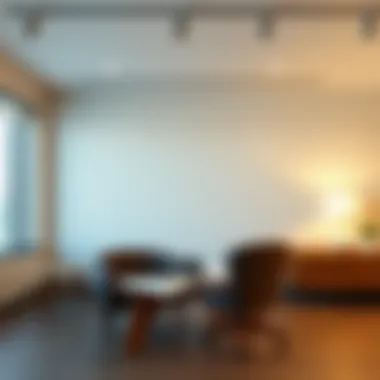The Functionality and Aesthetics of Chairs with Desks


Intro
Chairs with attached desks have emerged as more than just functional furniture in our modern world. They represent a convergence of efficiency, style, and ergonomics, especially suited to the diverse needs of educational institutions, corporate offices, and home environments. The blend of artistry and practicality in their design serves not just a purpose but also enhances the aesthetics of any space.
These multifunctional pieces reflect the growing trend towards minimalism and space optimization in interior design. In an age where urban living often means smaller living spaces, these integrated solutions provide a way to maximize functionality without compromising on style. This exploration delves into various facets of these chairs with desks attached, providing insights into their relevance and the numerous styles that have garnered popularity.
Furniture Styles and Trends
Design trends for furniture evolve just as rapidly as the needs of the consumers change. When it comes to chairs with attached desks, a variety of styles is out there, catering to different tastes and functions.
Modern vs. Traditional: Understanding the Aesthetics
When distinguishing between modern and traditional designs, one might first notice the stark contrasts in the materials and shapes favored.
- Modern designs are characterized by sleek lines and innovative materials. They often utilize metal and molded plastics. This not only fosters a contemporary look but also ensures lightweight and ease of mobility, which meets the demands of fast-paced environments.
- Traditional styles, on the other hand, showcase rich woods and plush upholstery, emphasizing craftsmanship and durability. They create a more inviting and warm atmosphere, perfect for settings like home offices or conference rooms that seek to encourage communication and collaboration.
Regardless of the style, both modern and traditional chairs with desks can harmonize well in a variety of settings. Your personal or office aesthetics will dictate which design to choose.
Color and Material Trends: What’s In and What’s Out
As we step further into this decade, certain color palettes and materials start to emerge as frontrunners in the furniture landscape.
- Earthy tones like terracotta, olive green, and soft beige are particularly popular, embodying the sustainable focus of today's design philosophies.
- Natural materials, including bamboo and reclaimed wood, are not only ecologically friendly but also add texture and warmth, making spaces feel more balanced.
- Meanwhile, bright vibrant colors like cobalt blue and fiery orange have found favor in creative office spaces, aiming to inject energy and inspire creativity.
In summary, as you think through your own choices in furniture, align your selections with these trends for a well-rounded approach.
Furniture Care and Maintenance
Taking good care of your furniture extends its life and maintains its aesthetic appeal. Chairs with attached desks are no exception.
Tips for Prolonging the Life of Your Furniture
- Regular Cleaning: Dust and dirt can wear down surfaces over time. A simple wipe with a damp cloth could go a long way.
- Proper Usage: Ensure that the chair is used solely for its intended purpose. Excessive weight or misuse can damage the integrated structures.
- Protective Coatings: For wooden furniture, consider using varnishes or protective sprays to help buffer against scratches and moisture.
DIY Repair Hacks for Common Furniture Issues
Small nicks and scratches can often be remedied without calling a professional.
- Furniture Markers: These can help conceal scratches on wooden surfaces effectively.
- Wood Glue: A simple solution for loose joints; apply a small amount and clamp until it dries.
- Fabric Repair Kits: For upholstered surfaces, these kits are widely available. They can help patch up small tears and keep your furniture looking neat.
Taking the time to care for your integrated furniture will not only preserve its beauty but also maintain its functionality for years to come.
As we weave through the functionality and beauty of chairs with attached desks, it becomes evident that these two aspects are not mutually exclusive. They can coexist to create spaces that cater hugely to our daily activities. By understanding the contemporary trends and applying practical maintenance advice, homeowners and enthusiasts alike can enhance their environments.
Intro to Chairs with Attached Desks
In today’s fast-paced world, where space and functionality are paramount, the concept of chairs with attached desks has materialized as a noteworthy solution. These dual-purpose pieces not only save valuable real estate in homes and workplaces but also streamline the user experience. From students focusing on their studies to professionals tackling their to-do lists, integrated seating facilitates an environment conducive to productivity.
Moreover, these chairs merge comfort with utility, enhancing not just the aesthetic of a space but also ensuring that function isn’t sacrificed in the name of style. With a myriad of designs available – from sleek and modern to classic and ornate – there is something for every taste and need.
Consider how a chair with an attached desk can transform a standard study area into a sophisticated workspace, or mimic a coffee shop vibe at home, giving life to mundane daily tasks. This article seeks to delve into the important aspects surrounding these hybrid pieces, analyzing their design features, applications, and the role they play in modern environments.
Definition and Overview
Chairs with attached desks are pieces of furniture designed to integrate seating and writing or working surfaces into a single unit. This clever combination allows users to enjoy the benefits of a workspace without the encumbrance of bulky, separate furniture. Often found in places like classrooms and open-plan offices, these chairs can come with various features, such as adjustable heights, ergonomic backs, and even storage compartments.


For homeowners and designers alike, understanding the specifications of these chairs is crucial. They come in various styles and functionalities, adapting to the needs of different users. Whether it’s a flip-top table for easily stowing away or a foldable design for saving space, every option has its merits. Shopping for these can feel like finding a needle in a haystack, but this convenience is worth the effort.
Historical Context
The genesis of chairs with attached desks can be traced back to educational settings. Originally, they were simple wooden structures designed to optimize learning environments in schools. In the late 19th and early 20th century, as industrial design began to pick up steam, these combined units evolved. They became more comfortable and user-friendly, reflecting the growing understanding of the relationship between ergonomics and productivity.
During the mid-20th century, adaptability became essential with the rise of modern schooling methods. This fueled a shift towards flexible designs that catered to changing needs—ultimately leading to the diverse range of options available today. From classrooms to corporate settings, the evolution has assured that functionality is front and center of design philosophy, marrying flora and function in one seamless approach.
As we explore further into the functionality and aesthetics of these chairs, it's vital to recognize that their importance goes beyond mere furniture; it encapsulates a lifestyle that blends practicality with aesthetics seamlessly.
Design Features
Ergonomic Considerations
When it comes to ergonomic design, the primary goal is to create a comfortable user experience. These chairs should support good posture while performing tasks, minimizing strain during long periods of use. Look for features such as adjustable seat heights and lumbar support. A chair designed with user ergonomics in mind can reduce fatigue and increase productivity, particularly in settings like classrooms and office environments.
For example, a chair that allows for a tilt option can encourage movement and active sitting. This dynamic movement encourages better blood flow and reduces the static load on muscles and joints. A poorly designed chair can lead to discomfort and potentially long-term health issues, but with the right ergonomic features, users can engage comfortably in work or study.
Material Choices
The selection of materials significantly influences both functionality and aesthetics. High-quality materials not only ensure durability but also affect the overall look of the chair and attached desk. Common materials include wood, metal, plastic, and composites. Each has its pros and cons concerning weight, maintenance, and visual appeal.
- Wood is often favored for its classic aesthetic and sturdiness. It's versatile, fitting into traditional or modern spaces.
- Metal is celebrated for its strength and contemporary look, often used in sleek and minimal designs.
- Plastic can be molded into various shapes, allowing for innovative designs that can be lightweight and easy to clean.
The trend towards sustainable materials cannot be ignored either. Recycled or eco-friendly materials add an extra level of appeal for environmentally conscious consumers. Using materials that are both sustainable and stylish is a way to make a statement about personal values while still prioritizing function.
Aesthetic Styles
Aesthetic considerations bring a unique flavor to chairs with attached desks. The styles can range from industrial chic to cozy rustic, thereby fitting seamlessly into diverse interior designs. Take a close look at current trends such as:
- Minimalism, which embraces clean lines and uncluttered designs, making spaces feel more open.
- Scandinavian designs characterized by simplicity, form, and functionality, where beauty lies in minimalism and utility.
- Mid-century modern, popular for its classic influences, that seeks to meld function with form in stylish ways.
These aesthetic styles contribute not just to the look but also to the emotional experience of the space. A well-designed chair and desk can inspire creativity and productivity, helping to create environments that feel welcoming and engaging. Investing in pieces that resonate with the desired aesthetic can breathe life into both personal and professional spaces.
In summary, the design features of chairs with attached desks encompass ergonomic considerations, material selection, and aesthetic styles, all of which significantly contribute to their functionality and overall appeal. Whether employed in educational settings or home offices, the right choices can lead to a perfect blend of comfort, style, and practicality.
Applications in Various Settings
The integration of chairs with attached desks plays a vital role across multiple domains, significantly enhancing the functionality and usability of spaces. The built-in desk element not only saves space but also promotes organized work environments, which can boost productivity and focus. In today's fast-paced world, where compactness and efficiency are crucial, these dual-purpose solutions meet both practical and aesthetic needs in home, education, and professional settings.
Educational Institutions
Classroom Environments
In classrooms, chairs with attached desks serve as a practical answer to managing limited space. Teachers and students benefit from the convenience of having a workstation that is ready for note-taking or digital engagement. This setup accommodates various classroom arrangements, allowing for flexibility in group activities or individual focus.
One significant characteristic of classroom settings utilizing integrated furniture is the promotion of interaction. Students can easily turn and engage with their peers without the hassle of moving individual desks. A unique feature of these chairs is their ability to allow easy mobility during collaborative projects, providing that seamless transition from group work to individual tasks. However, some may argue that the fixed nature of these chairs can limit movement and comfort for long periods, which presents a notable disadvantage—a concern for hours spent in learning.
Lecture Halls
Lecture halls are another domain where the functionality of attached desk chairs shines. Here, the combination aids in maximizing seating while accommodating more individuals in tight spaces. This aspect is especially crucial during larger classes where lecture attendance is critical. The fixed configurations of these chairs usually facilitate easier navigation of aisles while ensuring that students have an assigned workspace.
The key characteristic in lecture halls can be seen in the integration of ergonomic designs tailored for extended sitting. Professors and students alike appreciate how these setups contribute to comfort during longer sessions. The downside is often the presence of limited personal space, which might not favor all students, especially in larger classes.
Library Spaces
Library spaces often require environments that foster quiet study and concentration, making chairs with attached desks an excellent fit. These setups provide designated spots for reading or working on assignments without the need for extensive furniture arrangements. The inherent nature of these chairs encourages focused study by limiting distractions that might arise from moving around, thus promoting an atmosphere of silence and reverence for knowledge.


A key feature is the compact form and ability to blend in with various library designs, from traditional to modern aesthetics. However, the lack of adjustable height options may pose challenges for users of different statures, impacting comfort levels and usability. Still, the general appeal remains strong as they serve as both a space-saving solution and a promotional tool for productivity in educational settings.
Corporate Workplaces
Collaborative Workspaces
In corporate settings, particularly in collaborative workspaces, the use of chairs with attached desks offers distinctive benefits. These spaces design for teamwork are typically filled with individuals engaging in discussions or brainstorming sessions. Integrated furniture aids in facilitating easy movement and interaction among team members.
One of the notable characteristics here is their design flexibility, allowing businesses to create environments conducive to innovation and teamwork. The advantage lies in the transference of ideas and resources with minimal friction between different groups or activities. The downside, however, comes with the potential limitation in personal space, which may hinder productivity for those who prefer solitude for focus.
Home Office Solutions
The home office trend has surged in recent years, accentuating the importance of multifunctional furniture. Chairs with attached desks serve as ideal solutions for individual workspaces, minimizing the clutter that often comes with standalone desks and chairs. A home office implicitly encourages a sense of professionalism and organization, ensuring a productive work atmosphere.
One compelling aspect is their adaptability, fitting into various home styles and sizes. Customizable options allow users to select finishes that align with their interior's aesthetics. However, those who prioritize comfort for extended periods may find that a fixed chair limits options, suggesting a potential trade-off between aesthetics and ergonomics.
Flexible Work Arrangements
Flexible work arrangements are redefining traditional office frameworks, making chairs with attached desks increasingly relevant. They cater to the need for dynamic setups that can adapt to changing workloads and staffing needs. These pieces are particularly beneficial in environments where hot-desking is prevalent, as they eliminate the need for finding separate desks and chairs.
The characteristic that sets these arrangements apart is mobility; being able to easily reconfigure spaces enhances collaboration and camaraderie among employees. However, there are concerns regarding long-term comfort, particularly for employees needing to shift between sitting and standing—an aspect that needs attention as companies adopt these integrated solutions to support diverse work styles.
"As workplaces evolve, the importance of versatility in furniture grows, fostering connections while addressing personal comfort and efficiency."
Ultimately, the applications of chairs with attached desks in various settings speak volumes about their practicality in modern design. Whether in classrooms, lecture halls, libraries, or corporate environments, their multifaceted use enhances the utility without sacrificing style.
Technological Integration
In a world where technology seeps into every corner of our lives, the realm of furniture design isn't left behind. Chairs with attached desks are not merely utilitarian pieces anymore; they are fast evolving into smart solutions that blend the digital and physical workspace harmoniously. This integration improves overall functionality while also enhancing the aesthetics that cater to the modern individual. Whether in a classroom, a corporate environment, or a cozy study, the inclusion of technology in these designs reflects our changing needs, be it for convenience or innovation.
Smart Features
Built-in Charging Stations
One standout feature in these dual-purpose designs is the built-in charging stations. With an ocean of devices that demand power, having a direct power source can feel like finding a pearl in an oyster. These stations offer the luxury of being connected without tripping over cords or searching for outlets. For anyone who spends hours studying or working, the convenience of a charging station built into a chair can’t be overstated. Besides, it eliminates the clutter of cords scattered around desks, lending to a cleaner and more organized look.
That said, not all charging stations are created equal. Some might only provide USB ports, restricting flexibility with various device requirements. Plans for embedding wireless charging could be the future, but here and now, being able to keep devices charged while seated is a major win.
Adjustable Components
Another noteworthy smart feature is adjustable components. This aspect caters to individual comfort, allowing users to modify chair height or desk level based on their unique needs. It's like having a customized fit that adjusts to your work style rather than forcing you into a generic mold.
This feature proves particularly beneficial for educational settings where students vary in height and size, ensuring everyone can access the workspace comfortably. However, adjustments may sometimes be mechanical, with wear and tear possibly leading to maintenance challenges over time. Ease of adjustment should be a critical consideration in the design process, facilitating straightforward user interaction without complicated setups.
Impact on Productivity
Ultimately, the smart features in chairs with attached desks contribute significantly to productivity. According to various studies, a well-designed workspace, loaded with user-friendly technology, can lead to greater efficiency and satisfaction. When individuals can plug in and adapt their setup quickly, they can focus better on tasks without hindrance. In summary, integrating technology into design not only meets functional demands but also aligns aesthetic appeal with modern living demands.
"The future of furniture is not only about comfort, but how seamlessly it fits into our connected lives."
For more insight into the relationship between productivity and workspace design, check out Harvard Business Review or Ergonomics.org.
By marrying these design elements with thoughtful technology, we create spaces that are not only functional but also invigorating, enhancing the everyday experience for users.
Trends in Sustainable Design
Sustainability is no longer just a buzzword; it’s a necessity. In the furniture industry, particularly concerning chairs with attached desks, there is a growing trend towards sustainable design practices. This is vital not only for the environment but for enhancing the aesthetic and functional qualities of integrated furniture pieces. Everyday, homeowners, designers, and manufacturers are becoming more mindful of how their choices impact the planet, hence fostering a rise in eco-friendly alternatives and responsible manufacturing processes.


The focus on sustainability serves as a bridge connecting form and function, allowing integrated furniture to not only look good but also contribute positively to the environment. These trends root in both ethical considerations and practical benefits—reducing waste, conserving energy, and creating healthier environments.
Eco-Friendly Materials
A fundamental aspect of sustainable design is the choice of materials used in manufacturing chairs with attached desks. The move toward eco-friendly materials is all about reducing the carbon footprint associated with production and disposal. Here are some popular options:
- Recycled Materials: Using recycled plastics or metals not only minimizes waste but also lowers the demand for new resources. Products made from recycled content are increasingly seen in modern furniture designs, bridging style with sustainability.
- Bamboo: This fast-growing plant is a favorite in eco-friendly furniture. Its high strength-to-weight ratio and rapid regeneration make bamboo an excellent alternative to traditional hardwoods.
- Natural Finishes: Organic adhesives and non-toxic finishes can enhance the aesthetic qualities of furniture while ensuring that harmful chemicals do not leach into the environment. This consideration is especially important for spaces used by children, like schools and playrooms.
Incorporating these eco-friendly materials not only reflects a commitment to sustainability but also honors the craftsmanship that goes into creating beautiful, functional pieces. More often than not, these choices inspire a conversation about the importance of sustainability within interior spaces.
Life Cycle Assessments
Understanding the life cycle of a product is critical to grasping its overall sustainability. Life Cycle Assessments (LCAs) allow consumers and manufacturers alike to evaluate the environmental impacts of chairs with attached desks from cradle to grave. This includes:
- Raw Material Extraction: How materials are sourced impacts the environment significantly. Sustainable practices in this phase reduce negative repercussions on ecosystems.
- Manufacturing Processes: Energy efficiency in factories and waste management practices are crucial. Green manufacturing processes strive to minimize emissions and waste, which directly influence the product’s sustainability.
- Use and Durability: Products designed with longevity and resilience in mind lessen the frequency of disposal. A durable chair-and-desk combo enhances its utility over time.
- End-of-Life Considerations: Responsible disposal, whether through recycling or composting, ensures that the environmental footprint is minimized as the piece reaches the end of its life cycle.
By implementing Life Cycle Assessments, both consumers and manufacturers can make informed choices that resonate with sustainable goals. This proactive approach can significantly influence design trends while fostering greater environmental accountability within the industry.
"Sustainable design is about creating products that contribute positively to our world while fulfilling our needs for beauty and function."
In summary, embracing trends in sustainable design transforms the landscape of chairs with attached desks into a realm where ecological consciousness meets aesthetic appeal. The journey from material choice to end-of-life considerations creates a holistic dialogue around responsible consumption and design.
Consumer Considerations
When it comes to purchasing chairs with attached desks, the options are plentiful, but so are the considerations. Understanding consumer considerations is like finding the compass in a dense forest. It helps navigate the multitude of products available while ensuring that you make choices that balance quality, functionality, and aesthetics. These chairs are not merely furniture items; they serve a practical need in our daily lives—a blend of seating and workspace that caters to efficiency and comfort.
Budget-Friendly Options
One of the most significant factors for consumers is their budget. With prices ranging widely, finding budget-friendly options can feel like searching for a needle in a haystack. However, there are numerous avenues to explore when looking for wallet-friendly choices without skimping on quality.
- Research and Compare: Websites like Amazon and Wayfair can be a treasure trove of information. A thorough comparison of prices can reveal sales or discounts. Don't shy away from refurbished options—you might find a gem that suits both your style and your pocket.
- Evaluate Offers: Sometimes local retailers offer deals that online sources may not provide. Checking your local furniture store might surprise you with special deals. Visiting stores also gives you the chance to physically test the chair, which is invaluable.
- Look for Upholstery Choices: Chairs with attached desks come in various materials. Faux leather or mesh options often come at a lower price point compared to genuine leather, while still providing a sleek and professional look.
Customization Possibilities
Customization can elevate a simple chair with an attached desk into something uniquely yours. The spectrum of customization possibilities is as varied as the colors in a painter's palette. Whether it’s adjusting features for ergonomic support or selecting aesthetic elements that fit your style, customization offers significant benefits:
- Personalized Features: Some chairs allow consumers to customize functions such as adjustable heights or tilt mechanisms to promote better posture. Brands like Herman Miller or Steelcase often provide options that adjust to the user's body, which is crucial for those who spend extended hours seated.
- Color and Material Choices: The visual appeal of your chair can be as important as its function. From the color palette to the choice of fabrics, the right options can amplify the ambiance of your space significantly. Some manufacturers even allow for full personalization of upholstery—think custom prints or patterns that reflect your personal taste.
- Modular Designs: Brands are increasingly offering modular desks that let you swap out elements. This means if you want a change in aesthetic down the line, or if a functional need evolves, it's as easy as pie to just switch a piece out rather than buying a whole new setup.
"The beauty of customization is that it takes a standard product and makes it uniquely yours, merging functionality with personal flair."
By weighing budgetary constraints against customization desires, consumers can take their time to explore the market thoroughly. It's not just about obtaining a chair; it's about making informed choices that reflect your identity while meeting practical needs.
Finale and Future Outlook
As we reach the end of our exploration into the functionality and aesthetics of chairs with attached desks, it is evident that these integrated pieces of furniture play a significant role in our daily environments. These are not merely conveniences; they embody a shift in how we perceive workspace and ergonomics. With the perspective changing towards multifunctionality, it becomes vital to consider how these chairs can adapt to our ever-evolving needs.
The importance of integrated furniture cannot be overstated. It caters to the current trend of maximizing space without compromising comfort and usability. From educational settings to corporate offices, chairs with attached desks have become essential for encouraging productivity and organization. For homeowners seeking to optimize small spaces, integrated seating solutions present an elegant answer that brings together form and function seamlessly.
The Evolving Role of Integrated Furniture
Integrated furniture, like chairs with attached desks, illustrates a response to contemporary demands for flexibility in design. As work-life boundaries blur, the lines in furniture design are similarly fading. These chairs represent a practical solution that meets the requirements for both collaborative work and personal study.
- Space-Saving Design: This aspect is particularly vital in urban environments where square footage comes at a premium. Users can benefit from furniture that serves multiple purposes in a limited area.
- Encouragement of Collaboration: In places like offices, furniture that combines seating and workspaces encourages collaboration. Employees can gather around these pieces, sharing ideas more spontaneously.
- Aesthetic Value: Today’s integrated furniture doesn’t sacrifice style for practicality. Sleek designs and customizable options appeal to various tastes, making such pieces attractive to a range of consumers.
In essence, the role of integrated furniture is evolving into an integral part of our lifestyle rather than just a functional necessity.
Predictions for Future Innovations
Looking ahead, it’s crucial to consider how technological advancements will shape the future of integrated furniture. The possibilities are vast, and the implications of these innovations promise to revolutionize our work and living conditions.
- Smart Furniture: Imagine chairs that adjust automatically based on user preferences or provide feedback on posture. The incorporation of sensors that track health data and adjust accordingly could become commonplace.
- Sustainable Materials: With increased awareness of environmental issues, future innovations will likely focus on sustainable production. Biodegradable components and eco-friendly manufacturing processes could become the standard for furniture production.
- Customization Options: As consumers seek unique furniture, we can expect to see a rise in customization. Integrating modular components allows users to tailor their furniture according to preference, enhancing personal expression in design.
"The future of integrated furniture is not just about comfort and utility; it’s about enhancing the overall experience of the user within their space."















